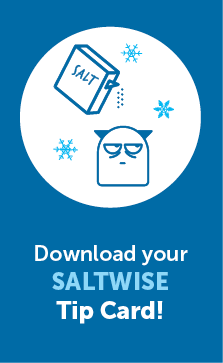Winter Salt Management Tips & Best Practices for Residents, Businesses, and Property Owners
Removing or preventing ice and snow doesn’t have to be difficult -- In fact, by following these simple steps, you can save time and money while protecting people, property, pets and the environment!
Be Salt-Wise!
Shovel early and often: Remove snow and clear pavement before snow turns to ice.
Consider Green Alternatives: There are many organic, salt-free and pet-safe de-icers on the market today. Products containing calcium magnesium acetate (CMA) are more eco-friendly. Remember to use these products sparingly, and don’t expect them to replace the need for shoveling. In addition, scattering sand on icy surfaces can provide temporary traction and reduce the danger of slipping.
Go easy!: Sprinkle de-icers sparingly and evenly. Read the directions carefully and apply the least amount necessary. More is not better. When applied properly, it won’t take much to get the desired results. Leave space between the grains. Using a lawn spreader can help spread deicer evenly and prevent clumping.
- Know when to treat: De-icers and salt are not meant to replace the work of shoveling. They are meant to loosen ice so it can be shoveled away.
- Check the temperature and weather conditions: Let the sun be your friend! It can do the work for you. If temperatures are expected to rise, de-icers or salt may not be needed.
Choose wisely: Weather conditions can change the effectiveness of certain de-icers. Check that your de-icer is designed to work for the current temperature and conditions. Only apply to surfaces that are already icy. When pavement temperatures drop below 15°, salt doesn’t melt ice.
Sweep: At the end of a weather event, sweep and collect any sand, salt, or undissolved de-icer. Any excess can be reused for the next storm. Letting them runoff into our waterways is harmful to our drinking water and wildlife.
Save Money: Adding too much salt is a waste of your money, and the environmental costs affect our whole community.


